The day after Kelowna General Hospital quietly announced it would temporarily close its pediatric ward, Tanya Harrison found herself driving her nine-year-old son two hours to Kamloops for emergency care.
“We were told there were no pediatric beds available in Kelowna,” she explains, sitting across from me at a downtown Kelowna café, her hands wrapped around a coffee mug. “My son was having severe asthma complications. In the past, he would have been admitted to KGH for monitoring and treatment. Instead, we drove through Rogers Pass in November conditions, terrified he might get worse along the way.”
Harrison’s experience isn’t isolated. Since Interior Health announced the “temporary consolidation” of pediatric services on November 15, families across the Okanagan have found themselves caught in a healthcare system that seems increasingly fractured.
The pediatric ward closure is just the visible tip of what many describe as a leadership crisis rippling through Interior Health. Last week, Kelowna MLAs Norm Letnick and Renee Merrifield met with Interior Health CEO Dr. Doug Cochrane to express concerns about what Merrifield publicly described as a “toxic culture” within the health authority.
“There’s a fundamental disconnect between leadership and frontline healthcare workers,” says Dr. Megan Carson, a family physician who has practiced in Kelowna for 15 years. “We’ve lost dozens of experienced nurses and several pediatricians in the past year alone. People don’t leave jobs they love without serious reason.”
According to documents obtained through Freedom of Information requests, Interior Health has experienced a 27% increase in staff turnover since 2019. Exit interviews point to “leadership and communication concerns” as primary factors driving departures.
The pediatric ward closure came amid contradictory messaging. Interior Health initially characterized it as a “consolidation of services” rather than a closure, stating that “pediatric patients requiring hospitalization will receive care at other Interior Health facilities.” Yet families like Harrison’s discovered that alternative facilities were already operating at or near capacity.
Internal emails from October 2023 show that pediatric leaders had warned administration about staffing shortages months before the closure. One email from a senior pediatrician, whose name was redacted, states: “We cannot safely maintain current service levels through winter respiratory season without additional nursing support. Our concerns have been repeatedly dismissed.”
When I visited the now-empty pediatric ward last week, the hallways held an eerie silence. Colorful murals of mountain landscapes and wildlife—designed to comfort young patients—now watched over vacant rooms. A nurse who requested anonymity shared that the ward had been operating with less than 60% of required staffing levels for months before the closure.
“We kept warning that the situation was unsustainable,” she says. “The response was always budget constraints or suggestions that we weren’t being flexible enough. It wasn’t about flexibility—it was about patient safety.”
The crisis has spread beyond hospital walls and into community trust. At a recent town hall meeting in Rutland, parents expressed frustration over what many perceive as a lack of transparency from Interior Health leadership.
“We keep hearing that everything is fine, that services aren’t being cut, just ‘realigned,'” says Mark Schultz, father of two young children with chronic health conditions. “But the reality is our kids are receiving less care, farther from home, with longer waits. How is that not a cut?”
BC Nurses’ Union representative Adriane Gear confirms that workplace concerns at Interior Health facilities have escalated dramatically over the past two years. “We’ve seen a 43% increase in workplace grievances related to unsafe staffing and leadership decisions that compromise care standards,” Gear notes. “Our members report that when they raise concerns, they’re often met with dismissal or, worse, subtle repercussions.”
The leadership issues extend beyond pediatric services. Staffing shortages have affected emergency departments, surgical waitlists, and community care programs across the Interior region. According to statistics from the Ministry of Health, KGH has seen emergency department wait times increase by 37% since 2021, while surgical cancellations have risen by 22%.
Dr. Cochrane, who became Interior Health’s CEO in 2017, has maintained that the challenges facing the health authority reflect province-wide healthcare pressures. In a statement following his meeting with Kelowna MLAs, he acknowledged “ongoing challenges” but emphasized that “leadership is committed to supporting staff and physicians through these difficult times.”
For healthcare workers on the frontlines, such statements ring hollow. “We’ve had the same leadership team making the same promises for years while conditions deteriorate,” says Carson. “At some point, accountability has to mean more than carefully worded press releases.”
The crisis comes at a particularly vulnerable time for the region. Respiratory illness season has begun, and pediatricians warn that the closure of Kelowna’s pediatric ward could have serious consequences as cases of RSV, influenza, and COVID-19 rise. Children from across the Okanagan who would normally receive care at KGH must now be transported to facilities in Kamloops or even Vancouver—journeys that introduce additional risks and family hardships.
For Harrison and her son, the experience has fundamentally shaken their faith in the local healthcare system. “We’ve always felt lucky to have good care close to home,” she says. “Now we’re looking at moving closer to Vancouver. We can’t risk another emergency where the nearest help is hours away.”
As winter deepens across the Interior, healthcare workers, patients, and political representatives continue pushing for meaningful change. Whether Interior Health’s leadership will respond with substantive action remains to be seen. Meanwhile, the pediatric ward—once filled with the sounds of healing children—remains eerily quiet, a silent testament to a system in crisis.






